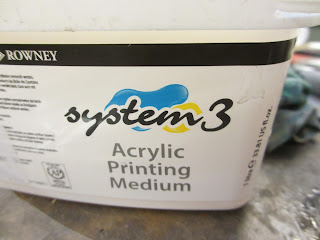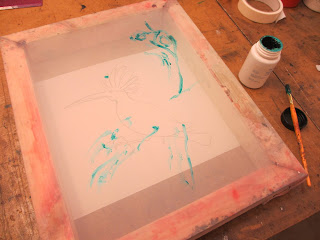Introduction
I have previously identified the artist Mandy Payne as an artist who is inspired by urban landscape, Brutalist architecture, social housing and finding beauty in the ordinary/overlooked. Mandy's practice therefore resonates with my own interests. She works with materials which have a physical connection to the sites she depicts, such as concrete and spray paint, building up flat zones of colour:
https://mandypayneart.co.uk/
I recently interviewed her and a record of our discussion features in my Blog of 23rd August, 2019. I will not go over the same ground here, but following our discussions Mandy was kind enough to send me an invitation to the launch of her current Exhibition, "Out of Time" at the Huddersfield Art Gallery. Details of the Exhibition can be found at:
https://www.kirklees.gov.uk/beta/museums-galleries-history/huddersfield-art-exhibitions.aspx
Huddersfield Art Gallery
Exhibition Launch, Saturday, 12th October, 2019
Mandy explains her work to visitors
I went along to the Gallery for the launch and was lucky to be able to have another chat with Mandy during which she expanded on her painting and printmaking practice, and in particular, her expertise in stone lithography. She gave me details of a print workshop which specialises in this area.
I chat with Mandy at the Launch as we discuss her prints
Mandy emphasised how she is inspired by the physicality of the materials she works with.
Mandy has now also introduced marble and fibre glass as well as concrete as a surface for her paintings. She has also introduced additional media, such as marker pen and ink to her work.
I have previously introduced such concepts into my own work. In particular, I have used steel and aluminium as a medium for prints featuring factories and industrial buildings.
Buxton House, 2019, spray paint and oil paint on concrete
St George's Warehouse, 2019, spray paint and oil paint on concrete
Looking at the Overlooked, 2019, spray paint, oil paint, marker pen, ink and varnish on glass fibre reinforced concrete panel
Out of Time, 2019, spray paint, oil paint, marker pen, ink and varnish on glass fibre reinforced concrete panel
Remnants of a Welfare State, 2019, spray paint, oil paint, marker pen on glass fibre reinforced concrete panel
Kirklees College, 2019, spray paint, oil paint, lithograph ink and varnish on canvas
Glass cabinet of prints and printmaking tools
Mandy emphasises her social messaging with the use of pertinent, and sometimes political, overtones.
For the Many Not the Few, 2019, spray paint and oil paint on marble
Conclusions
Seeing Mandy's work emphasised the physicality of her work. Some of her paintings on concrete were set within a wooden frame, whilst others were hung without any frame. I think that the unframed concrete made more of an impact as the materiality of the substance was clearly in view. The gallery was well lit and the paintings hung spaciously. The glass cabinet was a good way of exhibiting the prints, some of which were printed on delicate Japanese paper stuck onto stone and varnished. Viewers were engaged and enthused by the exhibition and Mandy added to the experience with her "hands on" approach and interaction with those present.

































